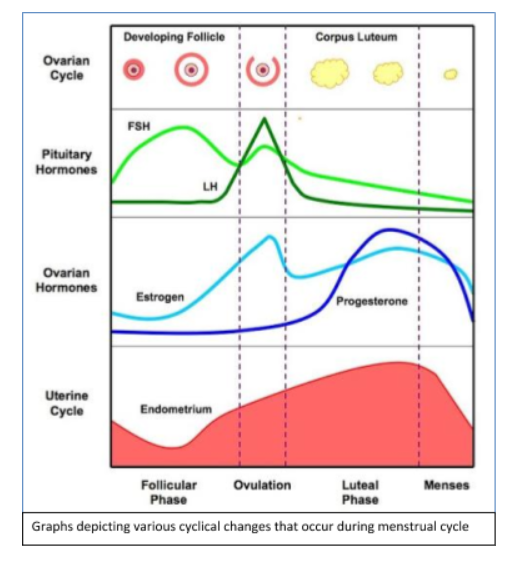Answer
425.4k+ views
Hint: The monthly cyclical changes which occur in the ovaries and lining of the uterus (endometrium) of females, starting with the preparation of an oocyte for fertilization to the shedding of endometrium is known as menstrual cycle.
Complete answer:Menstrual cycle is approximately a 28-day cycle. The cyclical changes which occur during menstrual cycles are quite dynamic in nature.
1. A secondary oocyte is prepared by oogenesis and the Graafian follicle starts growing larger by action of follicle stimulating hormone (FSH).
2. Simultaneously, the endometrium wall thickens. On day 14 or 15, ovulation occurs, luteinizing hormone level reaches its peak, causing ovulation.

3. Oocyte along with some cells gets released from the ovary and reaches the fallopian tube where fertilization could occur. Meanwhile, the uterus prepares for fertilization; follicle turns into corpus luteum, releasing progesterone.
4. After a period of about 24 hours, if fertilization does not occur, ovum reaches the uterus and signals for endometrial shedding.
5. The shedding marks initiation of a new cycle.
So, the correct answer is 1 i.e. true.
Note: The shedding of endometrial lining, blood and mucus is called menstruation. In other Primate females, the cyclical changes that occur are called oestrous cycles.
Complete answer:Menstrual cycle is approximately a 28-day cycle. The cyclical changes which occur during menstrual cycles are quite dynamic in nature.
1. A secondary oocyte is prepared by oogenesis and the Graafian follicle starts growing larger by action of follicle stimulating hormone (FSH).
2. Simultaneously, the endometrium wall thickens. On day 14 or 15, ovulation occurs, luteinizing hormone level reaches its peak, causing ovulation.

3. Oocyte along with some cells gets released from the ovary and reaches the fallopian tube where fertilization could occur. Meanwhile, the uterus prepares for fertilization; follicle turns into corpus luteum, releasing progesterone.
4. After a period of about 24 hours, if fertilization does not occur, ovum reaches the uterus and signals for endometrial shedding.
5. The shedding marks initiation of a new cycle.
So, the correct answer is 1 i.e. true.
Note: The shedding of endometrial lining, blood and mucus is called menstruation. In other Primate females, the cyclical changes that occur are called oestrous cycles.
Recently Updated Pages
How many sigma and pi bonds are present in HCequiv class 11 chemistry CBSE

Why Are Noble Gases NonReactive class 11 chemistry CBSE

Let X and Y be the sets of all positive divisors of class 11 maths CBSE

Let x and y be 2 real numbers which satisfy the equations class 11 maths CBSE

Let x 4log 2sqrt 9k 1 + 7 and y dfrac132log 2sqrt5 class 11 maths CBSE

Let x22ax+b20 and x22bx+a20 be two equations Then the class 11 maths CBSE

Trending doubts
Fill the blanks with the suitable prepositions 1 The class 9 english CBSE

At which age domestication of animals started A Neolithic class 11 social science CBSE

Which are the Top 10 Largest Countries of the World?

Give 10 examples for herbs , shrubs , climbers , creepers

Difference between Prokaryotic cell and Eukaryotic class 11 biology CBSE

Difference Between Plant Cell and Animal Cell

Write a letter to the principal requesting him to grant class 10 english CBSE

Change the following sentences into negative and interrogative class 10 english CBSE

Fill in the blanks A 1 lakh ten thousand B 1 million class 9 maths CBSE



